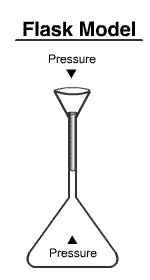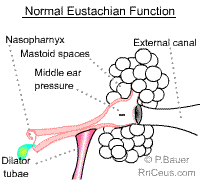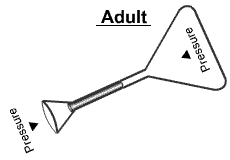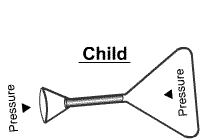
The eustachian tube performs at least 4 important functions:
Some of the protective functions of the eustachian tube, middle ear, and mastoid complex can be likened to the characteristics of a flask. Bluestone and colleagues compare the mouth of the flask to the nasopharynx. The neck represents the narrow portion of the eustachian tube. The bulbous portion of the flask represents the reservoir of air contained in the mastoid and middle ear.

Reflux
Reflux of fluid or pathogens into the neck of the flask is dependent upon pressure at either end. If a small amount of fluid enters the narrow neck of the flask it will stop somewhere within the neck. This is due to capillary action and a positive pressure which develops within the flask. The positive pressure is caused by the compression of the trapped gas within the closed chamber formed by the bulb.
 |
It is normal for the membrane which lines the middle ear complex to absorb gases from the middle ear. The absorption of gases creates a slight negative pressure within the ME.The negative pressure is equalized by air movement through the eustachian tube. Under some circumstances, fluid from the nasopharynx can enter the eustachian tube. If the amount of fluid is small and the nasopharyngeal pressure is not too great, the fluid can be ejected by mucociliary action before it enters the ME. (see animation) If the eustachian tube is blocked, a strong negative pressure can develop within the middle ear. If negative pressure is not equalized by ventilation, serous fluid can be drawn from the membrane and accumulate within the middle ear space. (not shown) |
Fluid and pathogens can be forced into the tube by applying a strong positive pressure to the entrance of the tube. One way this might occur is during a sneeze, when our nasal passages are blocked by swelling or we pinch our nose closed. Sneezing while the nasal passages are blocked can increase nasopharyngeal pressure causing a failure of the valve which protects the entrance to the eustachian tube.
In children, the flask model is a bit different. The child model has a much shorter neck. As a result, less pressure is required at the nasopharynx to force fluid and pathogens into the middle ear of children.
The flask model can be used to illustrate another difference between a child's anatomy and that of an adult. In an erect adult the eustachian tube inclines about 45 degrees. The child's eustachian tube inclines only about 10 degrees. An erect adult gains the benefit of gravity which acts to increase resistance to fluid entering the middle ear. Conversely an infant gains little benefit from gravity because the tube is nearly perpendicular to the force of gravity. Worse yet, a child feeding in the supine position actually has the full force of gravity driving fluid into the middle ear.
 
Equilibration and Drainage |
Drainage of the ME can also be modeled by the flask. When the flask is inverted gravity draws fluid down the neck. The pressure in the bulb is reduced by the movement of fluid down the neck. The pressure in the flask becomes negative relative to ambient air pressure and some fluid may remain in the neck.
Mucociliary action of the eustachian tube and equilibration of air pressure are normally sufficient to remove fluid from the middle ear. The ciliated cells of the distal tube move the fluid toward the nasopharynx. At the same time, muscles involved with swallowing expand the lumen of the tube, allowing gas exchange and equilibration.
The valsalva technique is what we usually employ to equalize pressure in our ME. We close our mouth, pinch our nose and bear down. The valsalva creates a strong positive pressure in the nasopharynx, sufficient to force air into our middle ear equalizing pressure and allowing fluid to drain. The pressure has to be enough to overcome the valve created by the redundant membrane of the nasopharyngeal orifice.
Perforation of the eardrum, either surgically or spontaneously by effusion, will also allow equilibration of ME pressure. Perforation allows flow through either eustachian tube or the external canal. Perforating the eardrum is similar to placing a second opening in a can of liquid, air can enter which allows the fluid to flow more freely.
Instant Feedback